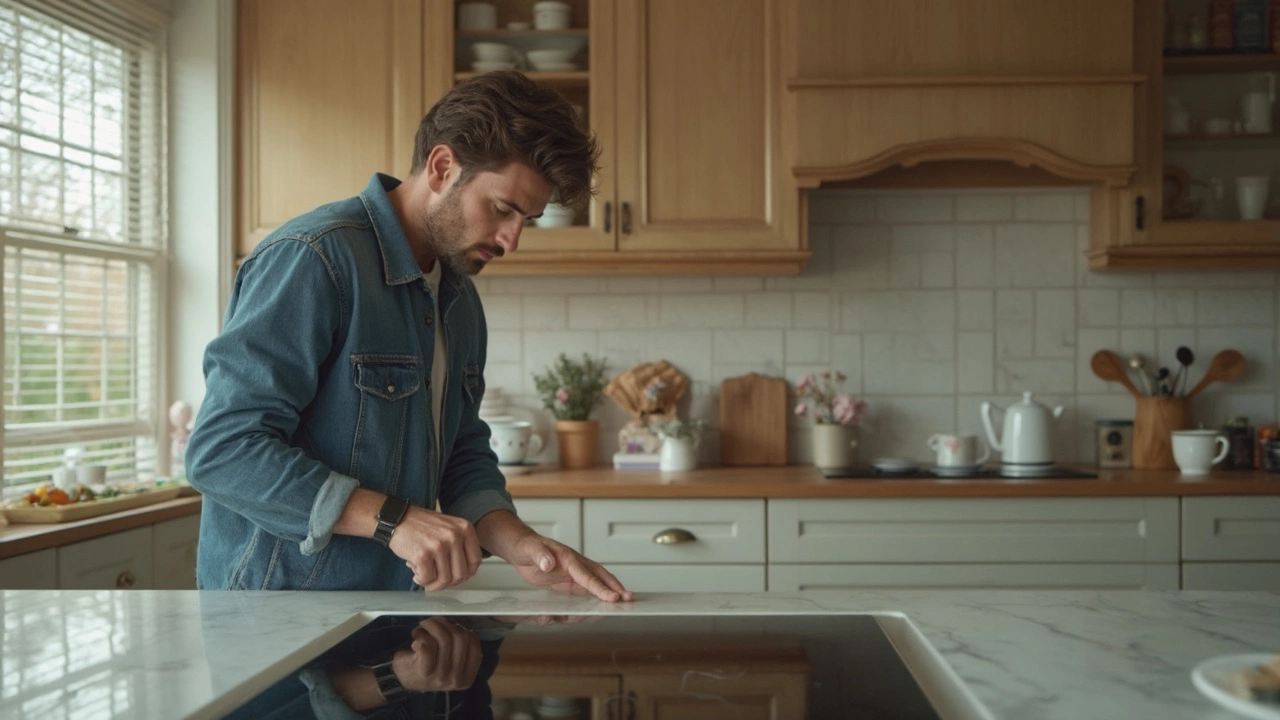If your electric hob won’t turn on, keeps flashing error codes, or just acts weird, you’re not alone. Hobs can trip up for loads of reasons—maybe you've had a tiny power cut, a spill got into the controls, or the child lock switched on when you weren’t looking. But here’s the good news: a quick reset often sorts things out.
To reset most electric hobs, just switch it off at the wall—yep, the main power supply, not just the hob’s on/off button. Wait about a minute (grab a drink, clean a surface, whatever). Then turn the power back on. That’s it. You’d be surprised how many times this simple trick fixes strange issues, from buttons not responding to the hob refusing to heat up.
- Why Electric Hobs Need Resetting
- The Fastest Way to Reset Your Electric Hob
- What If the Reset Doesn’t Work?
- Smart Tips for Avoiding Future Issues
- When to Call a Pro
Why Electric Hobs Need Resetting
Ever noticed your hob suddenly stops working or flashes some code you’ve never seen? There’s actually a reason for that. Most electric hobs are packed with safety sensors and digital controls. They’re smart, but they can be sensitive. Power surges, brief drop-outs, or a fuse tripping can confuse their brain, making the whole thing freeze or lock up.
Sometimes, the controls don’t respond after you’ve cleaned the glass, even if you just wiped it with a damp cloth. Water or cleaning spray can seep into the touch controls, causing errors or ghost touches.
Also, hobs automatically shut down if they detect overheating. If you’ve been boiling pasta and a pot boils over, the steam sensor might think things have gotten too hot. Or, if a pan is left on for a really long time, the hob shuts itself off for safety.
Then there are those classic moments where the child lock is accidentally switched on. Suddenly, nothing works—no matter how hard you press the buttons. And if your power company has a quick power cut and things blink back to life, hobs sometimes don’t recover as fast as your other appliances.
Here’s the kicker: most manufacturers actually recommend a full power cycle when anything weird happens. It’s the digital version of ‘turn it off and on again’ and works wonders with an electric hob. So, before you think your hob is broken, a reset might be all it needs.
The Fastest Way to Reset Your Electric Hob
When your electric hob gives you trouble, a reset is usually the easiest fix. You don't need fancy tools or a bunch of tech skills. Just a bit of patience and a basic understanding of where your hob’s power supply is.
Most electric hobs don’t actually have a dedicated reset button. What you’re doing is a “power cycle”—the same trick you use when your Wi-Fi router acts up. Here’s how to do it right:
- First, turn off all the hob controls. Make sure nothing is left on or glowing.
- Next, find the main power switch—this is usually a wall switch near the appliance, or the circuit breaker in your fuse box.
- Flip the switch or breaker to the “off” position. Wait at least 60 seconds. This gives the internal circuits time to clear out any stuck signals or errors. In tough cases, wait up to five minutes.
- Turn the power back on by flipping the switch or breaker to “on.”
- Now, test the hob. Press the power or touch controls to see if it’s responding normally. Look for any error codes—most should disappear after the reset.
If you’re not sure how much time to wait, here’s a quick table showing how long different brands recommend:
| Issue | What to Check | Who Should Fix? |
|---|---|---|
| Display won’t light up | Power supply, fuse/trip switch | You/Pro |
| Flashing error code | Error code meaning in manual | You/Pro |
| Burning smell | Signs of melt, turn off immediately | Pro |
| Constant tripping breaker | Wiring, supply, other appliances | Pro |
If your electric hob is still dead after all this, or you notice strange smells or repeated tripping, don’t mess with it. It’s time to call in a professional—they've got the gear and the know-how to deal with tricky or dangerous problems safely.
Smart Tips for Avoiding Future Issues
No one wants the hassle of a hob acting up right when you're about to serve dinner. Thankfully, keeping your electric hob running smooth doesn’t take a science degree. Start with the small stuff, like keeping the hob clean. Grease and food bits can sneak into the controls, and moisture can cause short circuits. Wipe it down with a damp (not soaking) cloth after each use and pay special attention to the edges where grime builds up.
Watch out for power surges. If your home gets hit with sudden electricity spikes, it can mess with the hob’s sensitive electronics. Plugging big kitchen devices like fridges and microwaves into separate circuits helps share the load. And if your area gets lots of storms or outages, consider a surge protector—some newer hobs actually recommend this in the manual.
Another easy win: don’t overload the cooking zones or put really heavy pots on the glass. This can weaken sensors underneath or even crack the top. If your hob has a child lock, use it. Accidental button presses from curious little hands or just brushing past the controls can change settings or trigger error messages.
"Most electric hob problems are down to accidental spills, user error, or power supply glitches—not a full-blown breakdown." – UK Appliance Repair Association
Stick to regular checkups every six months. Inspect the electric hob for chipped glass, loose dials, or weird smells while it’s on. If you spot anything odd, deal with it before it becomes a big headache.
Here’s a fast checklist to keep things sweet:
- Always clean spills straight away—dried gunk is a nightmare for sensors.
- Never use scouring pads or harsh chemicals; they scratch and damage surfaces.
- Don’t yank the power cord or plug in and out all the time.
- If your hob has a filter or vent, check it for dust every couple of months.
- Read the manual (yeah, really). It’s full of quick tips specific to your model.
Check out the table below for the most common causes of hob glitches and easy ways to avoid them:
| Issue | Prevention Tip |
|---|---|
| Spillages | Wipe down immediately after use |
| Power surges | Use a surge protector |
| Random shutdowns | Keep circuit loads balanced |
| Unresponsive controls | Enable child lock and clean controls regularly |
These small habits make a big difference, sparing you stress and unnecessary repairs down the line. Treat your hob right, and it'll keep serving you reliably meal after meal.

When to Call a Pro
Sometimes, no matter what you do, your electric hob just won’t play nice. Sure, you can handle a simple reset or wipe down a spill, but some problems need a trained eye. Here’s when it’s time to skip the DIY and call someone who knows what they’re doing.
- The hob trips your circuit breaker every time it’s turned on.
- You smell burning plastic or a weird electrical odor coming from the unit.
- You see sparks, hear buzzing, or notice scorch marks anywhere near the controls or surface.
- Error codes won’t go away after a reset, or the display is showing something you can’t find in the manual.
- Controls, touch panels, or any part of the hob works only some of the time, or never at all.
- There’s a crack on the glass surface, or you see signs of physical damage.
- Water or cleaning liquid got inside the hob and things started acting up right after.
Messing with the wiring or taking apart the hob on your own isn’t just risky—it might void any warranty left. Most brands, from Bosch to Hotpoint, specifically state in their manuals to let professional engineers handle anything to do with the inside electronics or power connections.
And here’s something most people don’t realize: a faulty electric hob can be a genuine fire hazard if left unchecked. According to the UK’s Electrical Safety First charity, kitchen appliances are linked with more than 14,000 fires a year. Most are caused by wiring problems or people ignoring those early warning signs.
| Sign | DIY or Pro? |
|---|---|
| Unit won’t power on, no smell or burns | Try reset first |
| Error code stays after reset | Call a pro |
| Repeated tripping of circuit breaker | Call a pro |
| Physical damage to surface or wiring | Call a pro |
| Touch controls not responding | Try reset, then call a pro |
Bottom line: if it’s electrical, smells odd, gets hot in the wrong places, or you’re just not sure, it’s safer (and probably cheaper in the long run) to bring in an expert.

